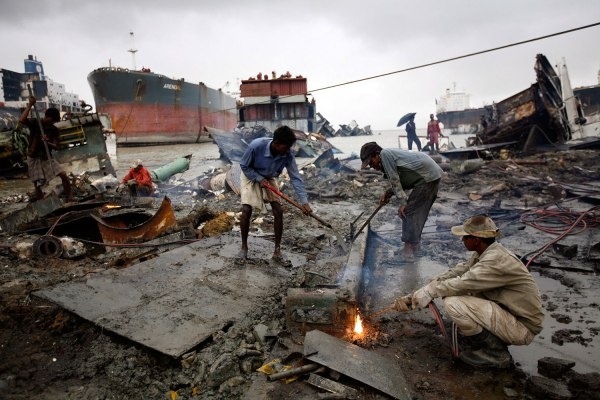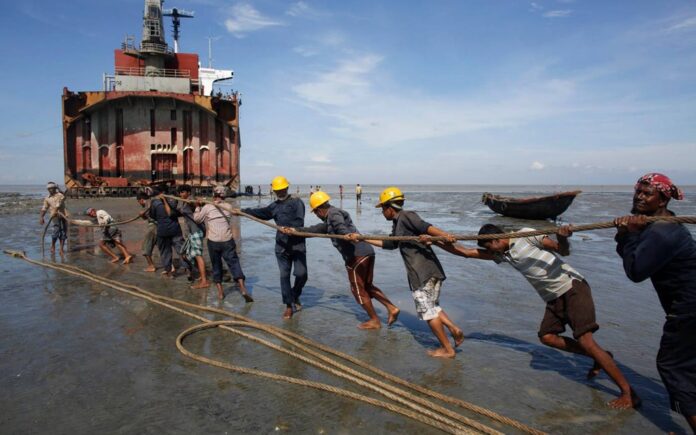On Bangladesh’s southwest coast, workers armed with gas torches, laser cutters, and winches dismantle massive, decommissioned ships that rest on the sandy shores.
Stretching along 15 kilometers of Sitakunda’s coastline, about 30 ship-breaking yards and thousands of scrap workshops collectively recycle nearly 38% of the world’s retired vessels, supplying crucial steel scraps to Bangladesh’s booming manufacturing sector.
“Cutting ships is one of the riskiest jobs on earth,” said Jamal Uddin, a 40-year-old senior cutter at a local yard.
Over the past two decades, Uddin has witnessed many colleagues suffer severe burns and broken limbs while working in nearby shipyards, where aging steel giants from wealthier, ship-owning nations arrive for dismantling.
With a significant number of old ships reaching the end of their operational lifespan, the industry is gearing up for a major surge in activity.
According to a recent report by the NGO Climate Group and consulting firm PWC, approximately 15,000 ships—equivalent to one-eighth of the global fleet—will be decommissioned for recycling over the next decade, doubling the volume of the previous ten years.
These older vessels are heavy polluters, emitting significant amounts of greenhouse gases and other pollutants. This has accelerated efforts within the industry to retire them, said Anand Hiremath, Chief Sustainability Officer at GMS, a company that purchases old ships and resells them to shipbreaking yards in South Asia.

Rising Concerns Over Emissions
If considered a country, the global shipping fleet would rank as the world’s sixth-largest emitter of carbon dioxide.
In response, the International Maritime Organization (IMO) has committed to cutting emissions by 50% by 2030, with a goal of achieving net-zero emissions by 2050.
New global regulations are being introduced to ensure safer and more environmentally responsible ship dismantling as part of a broader shift toward sustainability.
However, workers involved in shipbreaking argue that these reforms do little to improve their wages or working conditions.
“After a day of back-breaking labor, we barely earn enough to cover medical expenses or our children’s school fees,” said Uddin, who declined to disclose his employer’s name, fearing repercussions.
Most of the expected surge in ship recycling will be handled by yards in Sitakunda, Bangladesh, and Alang, India—two hubs that account for approximately 70% of the global shipbreaking industry.
Safety and Environmental Hazards
Workplace accidents, often fatal, remain a persistent issue, along with environmental damage caused by toxic substances leaking into the beaches and surrounding waters.
Shipbreaking exposes workers to numerous hazards, including high-temperature torch accidents and prolonged exposure to dangerous substances like asbestos, which pose serious long-term health risks.
In September, a fire at a Sitakunda shipyard claimed the lives of seven workers.
Since 2009, more than 470 workers have died across over 500 registered shipbreaking yards in South Asia, according to data from NGO Shipbreaking Platform, a coalition of environmental and labor rights organizations based in Brussels.
The industry employs at least 30,000 people across Bangladesh, India, and Pakistan—most of whom are low-paid, temporary workers.
“The recent accident highlights how far we still have to go to ensure a safe working environment for shipbreaking laborers,” said Fazlul Kabir Mintu of the Bangladesh Institute of Labour Studies (BILS), which collaborates with both shipyard owners and workers to improve safety conditions.
In June, the IMO is set to implement new regulations under the Hong Kong Convention, aimed at reducing risks to workers and regulating hazardous material management.
Under these changes, shipowners will be required to document any hazardous substances present in a vessel before it is sent for dismantling.
Demand for Fair Wages and Safer Conditions
Beyond improved safety measures, workers are also pushing for better wages and benefits, said Mohammad Ali from the Bangladesh Metalworkers’ Federation (BMF), who helped establish the country’s first shipyard trade union.
At Sitakunda’s yards, most workers earn less than $5 for an eight-hour shift under highly precarious conditions. Many lack formal identification, work on a temporary basis, and receive no paid leave, Ali explained.
Due to their low wages, workers often take on additional hours, increasing their exposure to dangerous working conditions.
In cases of fatal workplace accidents, workers’ families receive compensation of around 700,000 Taka ($5,740), an amount that barely covers two years of an average household’s expenses and does not include pension benefits.
Zahidul Haque, now in his 70s, lost his son Abdur Rashid—a junior cutter—in a fire at Pakiza Ship Yard nearly a decade ago.
“We received some compensation, but it was only 100,000 Taka ($820) at the time. Without our family’s primary earner, there is no one to support us,” Haque said.
Ensuring improved safety, better waste management, and stronger labor rights requires collaboration not just from shipyard owners but also from governments, said Mohammad Mahbubur Rahman of HR Ship Management, which helps shipyards comply with regulations.
While Bangladesh has been slow in adopting cleaner and safer shipbreaking practices, India’s shipyards have benefited from both government support and foreign investments, he added.
At the same time, pressure is mounting on wealthy nations—which own the majority of these vessels—to help bear the cost of this industry transition.
“Rich countries benefit from global shipping, so they must also take responsibility for how these ships are dismantled and the conditions of the workers handling them,” Ali from BMF emphasized.



